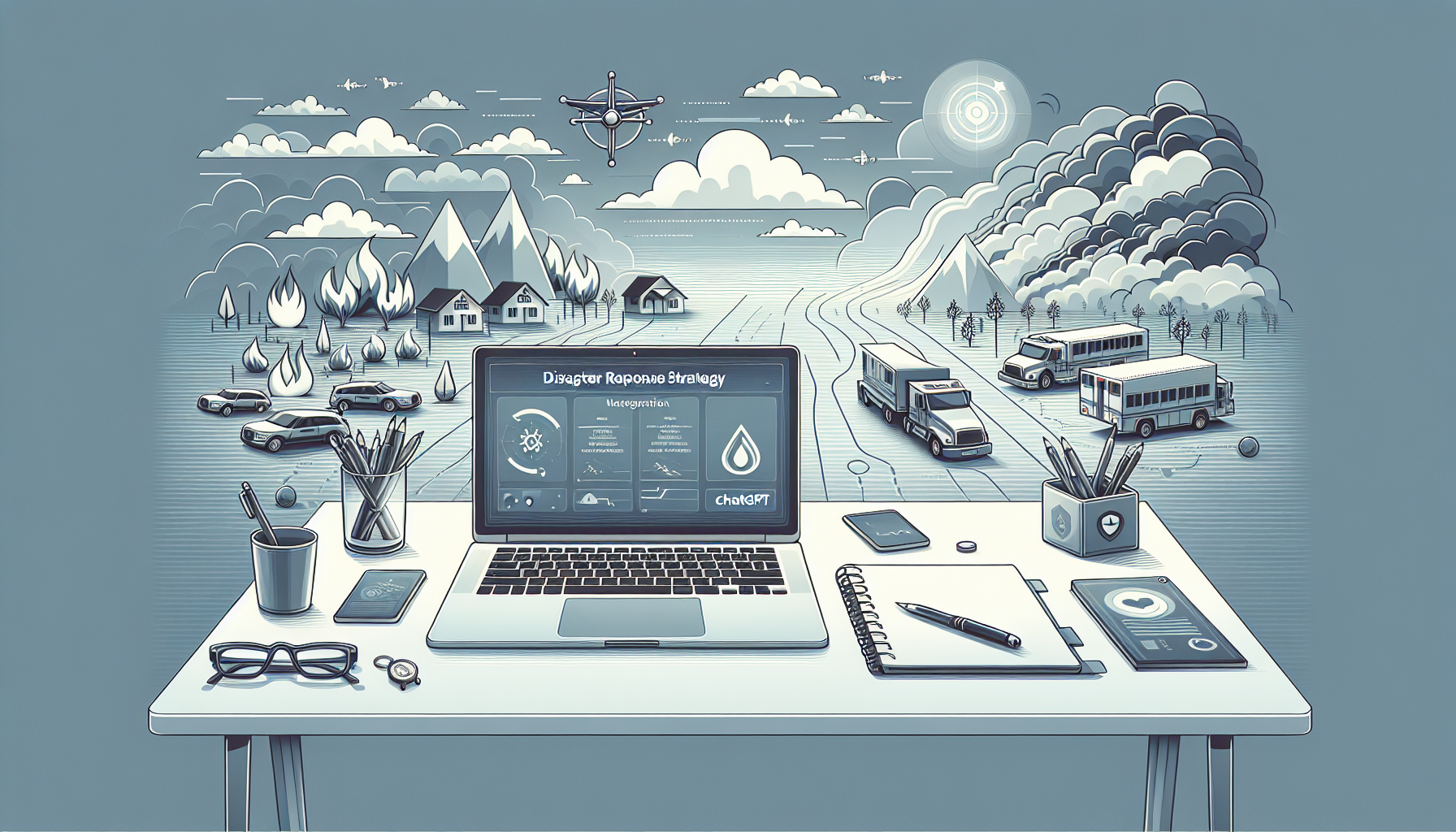Contingency planning can often feel like a daunting task, right? With so many potential risks and scenarios to consider, it’s easy to feel overwhelmed. But don’t worry; you’re not alone in this!
If you stick around, you’ll discover how to leverage the power of ChatGPT to create effective prompts that simplify your contingency planning process. Imagine having a trusty sidekick that helps you pinpoint risks and craft actionable strategies!
From crafting prompts for risk assessment to testing your plans, we’ll explore key techniques that can help ensure your organization is prepared for anything. Let’s dive in and make contingency planning a breeze!
Key Takeaways
- Use specific prompts in ChatGPT to identify key risks and develop strategies for contingency planning.
- Clear and precise language in your prompts will yield better insights for risk assessment.
- Focus on both internal and external scenarios that could disrupt your operations.
- Incorporate prompts into your emergency response plans to streamline actions during crises.
- Testing your plans with realistic scenarios helps identify weaknesses before a real emergency occurs.
- Ensure prompts encourage creativity and are easy to understand for maximum effectiveness.

Effective ChatGPT Prompts for Contingency Planning
Contingency planning is essential for any organization looking to navigate unexpected challenges smoothly.
The use of effective prompts in ChatGPT can significantly enhance these planning processes.
Here are some effective prompts to get you started:
- “List the top five risks that could impact our business operations over the next year.”
- “Generate a list of potential natural disasters and their impacts on our business.”
- “What are effective contingency actions for a cybersecurity breach?”
- “Summarize best practices for creating a business continuity plan.”
- “Explain how to communicate with stakeholders during a crisis.”
These prompts can help you identify key areas of focus, allowing for a proactive approach to emergency preparedness.
How to Create Prompts for Risk Assessment in Contingency Planning
Creating prompts for risk assessment is about precision and clarity.
Here are steps to craft effective prompts:
- Identify the specific risks you want to assess.
- Focus on relevant factors, such as industry trends and organizational vulnerabilities.
- Use clear, imperative language directed at ChatGPT.
For example, you might use the prompt:
- “Analyze the impact of supply chain disruptions on our production schedule.”
- “What are the risks associated with remote work adoption?”
- “Identify measures to mitigate financial risks during economic downturns.”
These prompts will provide valuable insights that can guide effective risk mitigation strategies within your contingency plan.
Prompts for Identifying Potential Risks and Scenarios
Identifying potential risks involves brainstorming multiple scenarios that could affect your organization.
Here are some prompts geared toward uncovering potential threats:
- “What scenarios could lead to operational disruptions for our business?”
- “List potential internal risks that may affect our resource allocation.”
- “How might changes in legislation impact our compliance efforts?”
- “Identify external factors that could create vulnerabilities in our service delivery.”
These prompts encourage a thorough evaluation of both internal and external risk factors, setting the stage for a comprehensive contingency plan.
Using ChatGPT Prompts for Developing Contingency Strategies
Developing effective contingency strategies is crucial for successful risk management.
Here are prompts that can help:
- “Outline a crisis management plan for sudden data loss.”
- “What steps should we take to ensure operational continuity during a pandemic?”
- “Create a communication strategy for informing employees about emergency procedures.”
- “Suggest alternative operational structures for critical business functions.”
These prompts guide the generation of practical, actionable strategies essential for robust contingency planning.
To gain further insights into using effective prompts, check out our article on prompts for creative writing to enhance your creative adaptability in planning scenarios.
Interested in more applications of ChatGPT? Read about its uses in education to understand how it can facilitate learning and planning alike.

Incorporating ChatGPT Prompts into Emergency Response Plans
Integrating ChatGPT prompts into your emergency response plans can streamline processes and enhance communication.
To effectively incorporate these prompts, follow these steps:
- Identify the key elements of your emergency response plan.
- Formulate prompts that address each element clearly and concisely.
- Utilize ChatGPT to generate detailed action plans based on these prompts.
Here are some useful prompts you can directly copy and paste:
- “Create a step-by-step emergency response procedure for a fire outbreak.”
- “What communication strategies should we implement during a natural disaster?”
- “List the roles and responsibilities of team members during an emergency.”
- “Outline a backup plan for critical systems in case of a power failure.”
Incorporating these prompts into your planning helps ensure that your team is prepared and knows exactly what to do in any emergency situation.
Testing Contingency Plans with ChatGPT Prompts
Testing your contingency plans is crucial for ensuring their effectiveness when life throws a curveball.
Here’s how you can use ChatGPT prompts for this testing process:
- Develop scenarios that mimic real-life emergencies.
- Create prompts that guide ChatGPT in simulating these scenarios.
- Analyze the responses to identify areas for improvement.
Here are specific prompts to help with your contingency plan testing:
- “Simulate an IT failure and outline how our team should respond.”
- “What immediate actions should we take in case of a data breach?”
- “Conduct a mock drill for communicating with stakeholders during a crisis.”
- “Evaluate the effectiveness of our response strategy for a health emergency.”
Using these prompts will help you validate your plans and prepare your team for real-world application.
Examples of ChatGPT Prompts for Business Continuity Planning
Business continuity planning ensures that your operations can withstand disruptions.
Utilizing ChatGPT prompts can help create effective strategies tailored to your organization’s needs.
Here are some prompt examples to kickstart your business continuity planning:
- “Develop a business impact analysis for our key services.”
- “What are the critical functions that must be maintained during a crisis?”
- “Provide a list of alternative suppliers for essential products.”
- “Outline a strategy for maintaining customer communication during disruptions.”
These prompts will help facilitate discussions and generate actionable plans that enhance your organization’s resilience.
Tips for Crafting Effective Prompts for Contingency Planning
Creating effective prompts for contingency planning requires thoughtfulness and clarity.
Here are some practical tips to help you craft prompts that will get the best results:
- Be specific: Clearly define the task you want ChatGPT to perform.
- Use simple language: Avoid jargon that could confuse the model.
- Encourage creativity: Ask open-ended questions to inspire more detailed responses.
Here are some prompt examples that follow these guidelines:
- “What innovative solutions can we implement for remote work during a crisis?”
- “Detail a checklist for ensuring compliance during emergency transitions.”
- “How can we engage employees in our contingency planning process?”
- “List the training requirements for staff regarding emergency protocols.”
Using these tips will enhance the effectiveness of your prompts and lead to better contingency planning outcomes.

Examples of ChatGPT Prompts for Business Continuity Planning
For effective business continuity planning, it’s helpful to have prompts that provide actionable insights tailored to your organization’s needs.
These prompts can guide you in creating strategies to ensure minimal disruptions during crises.
Here are some examples that you can copy and use directly with ChatGPT:
- “Write a detailed business impact analysis for our key operations.”
- “Identify critical business functions that must be prioritized during a disruption.”
- “Suggest alternative communication channels to keep customers informed during a crisis.”
- “Create a list of training programs for employees about business continuity procedures.”
- “Generate a contingency plan for maintaining supply chain operations during a disaster.”
Using these prompts can help generate a comprehensive business continuity strategy, making sure your organization remains resilient in the face of challenges.
Tips for Crafting Effective Prompts for Contingency Planning
Crafting effective prompts is key to unlocking the full potential of ChatGPT in your contingency planning.
Here are some practical tips to enhance your prompt creation:
- Be clear and specific with your requests to eliminate any ambiguity.
- Use straightforward language to ensure the model understands your needs effectively.
- Incorporate context where necessary to produce more focused responses.
- Encourage detailed answers by positioning your prompts as open questions.
Here are some crafted prompt examples following these tips:
- “List potential impacts of a pandemic on our workforce and productivity.”
- “Suggest innovative solutions for remote work during a crisis.”
- “Provide a checklist to ensure we meet compliance standards during emergency transitions.”
- “How can we improve staff engagement in our continuity planning efforts?”
Implementing these tips will help you obtain more relevant responses and refine your overall contingency planning process.
FAQs
ChatGPT can help identify and analyze potential risks by inputting specific scenarios. It can generate lists of risks, assess their impact, and suggest mitigation strategies tailored to your organization’s needs.
Consider prompts that ask about specific operations, projects, or external factors. Example prompts might include, “What risks are associated with our supply chain?” or “Identify risks related to a remote workforce.”
By using targeted prompts, ChatGPT can suggest various contingency strategies for each identified risk. These strategies may include preventive measures, response actions, and recovery plans that align with your organizational context.
Use clear, specific language and focus on particular scenarios or risks. Incorporate keywords related to contingency planning, and test different variations to yield comprehensive and actionable responses.
